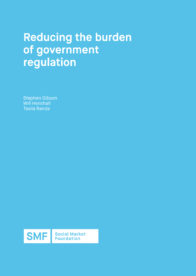Government regulations can result in higher consumers prices, make businesses less competitive, and they can prevent innovation and reinforce barriers to entry. In this paper, Harvard Senior Fellow and Regulatory Policy Committee Chair Stephen Gibson, reviews previous efforts to reduce red tape.
Several approaches to cutting the burden of government regulation have been in place in the UK and across the world. Evaluating them, RPC Chair Stephen Gibson identifies key lessons for policymakers:
- Clearly signal political support for initiatives to reduce regulation – regulatory burden reduction can often conflict with other political objectives. If burden reduction approaches are to be effective, it is imperative that they have strong political backing.
- Independently validate regulatory burden calculations – this ensures that the impacts of regulations are properly assessed and improves the quality of regulatory burden calculations.
- Set the scope of the framework appropriately – ensuring that significant regulations are not excluded from the burden reduction framework.
- Focus on the small number of regulations that generate most of the regulatory burdens
- Involve stakeholders – both to identify regulations that might be removed and providing evidence to quantify the burden reduction.
Gibson hopes that the Government will learn the lessons from past failures to improve the UK’s Better Regulation Framework and ensure that it is properly adhered to – as he says: “the potential benefits of getting it right are huge”.
The Retained EU Law Bill will sunset all retained EU legislation that hasn’t been reviewed or retained by December 2023 – this does not provide sufficient time to properly assess the roughly 4,000 pieces of law involved. Instead, Gibson and his co-authors call for the December 2023 deadline to be extended, and for a properly resourced and managed programme to assess inherited EU regulations – so as to not miss a ‘golden opportunity’ to reduce regulatory burdens and improve the regulations.

